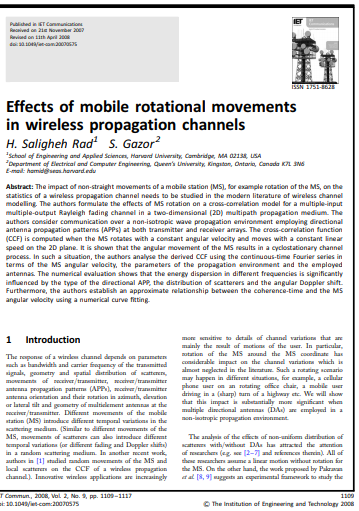Effects of Mobile Rotational Movements in Wireless Propagation
Abstract
The impact of non-straight movements of a mobile station (MS), for example rotation of the MS, on the statistics of a wireless propagation channel needs to be studied in the modern literature of wireless channel modelling. The authors formulate the effects of MS rotation on a cross-correlation model for a multiple-input multiple-output Rayleigh fading channel in a two-dimensional (2D) multipath propagation medium. The authors consider communication over a non-isotropic wave propagation environment employing directional antenna propagation patterns (APPs) at both transmitter and receiver arrays. The cross-correlation function (CCF) is computed when the MS rotates with a constant angular velocity and moves with a constant linear speed on the 2D plane. It is shown that the angular movement of the MS results in a cyclostationary channel process. In such a situation, the authors analyse the derived CCF using the continuous-time Fourier series in terms of the MS angular velocity, the parameters of the propagation environment and the employed antennas. The numerical evaluation shows that the energy dispersion in different frequencies is significantly influenced by the type of the directional APP, the distribution of scatterers and the angular Doppler shift. Furthermore, the authors establish an approximate relationship between the coherence time and the MS angular velocity using a numerical curve fitting.

